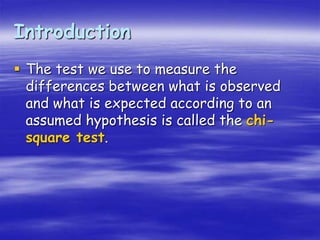chi square test lecture for nurses in pakistan
- 1. The Chi Square Test Muhammad Shahid Sr. lecturer IIN
- 2. Introduction ’é¦ We often have occasions to make comparisons between two characteristics of something to see if they are linked or related to each other. ’é¦ One way to do this is to work out what we would expect to find if there was no relationship between them (the usual null hypothesis) and what we actually observe.
- 3. Introduction ’é¦ The test we use to measure the differences between what is observed and what is expected according to an assumed hypothesis is called the chi- square test.
- 4. For Example ’é¦ Some null hypotheses may be: ŌĆō ŌĆśthere is no relationship between the height of the post RN and Generic BSN students ŌĆÖ. ŌĆō ŌĆśthere is no connection between the size of farm and the type of farmŌĆÖ
- 5. Important ’é¦ The chi square test can only be used on data that has the following characteristics: The data must be in the form of frequencies The frequency data must have a precise numerical value and must be organised into categories or groups. The total number of observations must be greater than 20. The expected frequency in any one cell of the table must be greater than 5.
- 6. Formula Žć 2 = Ōłæ (O ŌĆō E)2 E Žć2 = The value of chi square O = The observed value E = The expected value Ōłæ (O ŌĆō E)2 = all the values of (O ŌĆō E) squared then added together
- 7. ’é¦ Write down the NULL HYPOTHESIS and ALTERNATIVE HYPOTHESIS and set the LEVEL OF SIGNIFICANCE. ’é¦ NH ŌĆś there is no association between gender and hypertensive status ’é¦ AH ŌĆśthere is association between gender and hypertensive status ’é¦ We will set the level of significance at 0.05. Step 01
- 8. Construct a table with the information you have observed or obtained. Observed Frequencies (O) HTN Status Males Females N 50 50 PH 20 40 H 10 30
- 9. ’é¦ The number of degrees of freedom to use is: the number of rows in the table minus 1, multiplied by the number of columns minus 1. This is (2-1) x (3-1) = 1 x 2 = 2 degrees of freedom. Critical value X2=5.991 ’é¦ Look up the significance tables. These will tell you whether to accept the null hypothesis or reject it. Step 02 & 03 significance level
- 10. ’é¦ Step 04 calculation of calculated value HTN Status MALES FEMALES N E1=40 E2=60 PH E3=24 E4=36 H E5=16 E5=24 Expected frequency = row total x column total Grand total Eg: expected frequency for Normal male E1 = (100 x 80) / 200 = 40
- 11. HTN Status Males Females Row Total N 50 50 100 PH 20 40 60 H 10 30 40 Column total 80 120 200
- 12. O E O-E (O-E)2 (O-E)2 E 50 40 10 100 100/40 =2.5 50 60 -10 100 100/60 =1.66 20 24 -4 16 16/24 =0.66 40 36 4 16 16/36 =0.44 10 16 -6 36 36/16 =2.25 30 24 6 36 36/24 =1.5 (X2)=9.01 Add up all of the above numbers to obtain the value for chi square: Žć2 = 9.01
- 13. ’é¦ Comparison of critical and calculated value We find that our answer of 9.01 is greater than the critical value of 5.991 (for 2 degrees of freedom and a significance level of 0.05) and so we reject the null hypothesis.
- 14. Step Decision ’é¦ We reject the null hypotheses because the calculated value fall into rejection area
- 15. Step 06 conclusion ’é¦ There is an association between gender and hypertensive status at alpha 0.05















